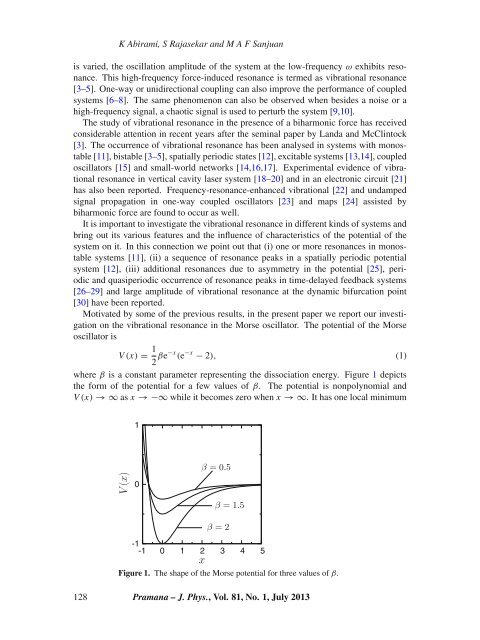Vibrational resonance in the Morse oscillator - Indian Academy of ...
Vibrational resonance in the Morse oscillator - Indian Academy of ...
Vibrational resonance in the Morse oscillator - Indian Academy of ...
Create successful ePaper yourself
Turn your PDF publications into a flip-book with our unique Google optimized e-Paper software.
K Abirami, S Rajasekar and M A F Sanjuan<br />
is varied, <strong>the</strong> oscillation amplitude <strong>of</strong> <strong>the</strong> system at <strong>the</strong> low-frequency ω exhibits <strong>resonance</strong>.<br />
This high-frequency force-<strong>in</strong>duced <strong>resonance</strong> is termed as vibrational <strong>resonance</strong><br />
[3–5]. One-way or unidirectional coupl<strong>in</strong>g can also improve <strong>the</strong> performance <strong>of</strong> coupled<br />
systems [6–8]. The same phenomenon can also be observed when besides a noise or a<br />
high-frequency signal, a chaotic signal is used to perturb <strong>the</strong> system [9,10].<br />
The study <strong>of</strong> vibrational <strong>resonance</strong> <strong>in</strong> <strong>the</strong> presence <strong>of</strong> a biharmonic force has received<br />
considerable attention <strong>in</strong> recent years after <strong>the</strong> sem<strong>in</strong>al paper by Landa and McCl<strong>in</strong>tock<br />
[3]. The occurrence <strong>of</strong> vibrational <strong>resonance</strong> has been analysed <strong>in</strong> systems with monostable<br />
[11], bistable [3–5], spatially periodic states [12], excitable systems [13,14], coupled<br />
<strong>oscillator</strong>s [15] and small-world networks [14,16,17]. Experimental evidence <strong>of</strong> vibrational<br />
<strong>resonance</strong> <strong>in</strong> vertical cavity laser system [18–20] and <strong>in</strong> an electronic circuit [21]<br />
has also been reported. Frequency-<strong>resonance</strong>-enhanced vibrational [22] and undamped<br />
signal propagation <strong>in</strong> one-way coupled <strong>oscillator</strong>s [23] and maps [24] assisted by<br />
biharmonic force are found to occur as well.<br />
It is important to <strong>in</strong>vestigate <strong>the</strong> vibrational <strong>resonance</strong> <strong>in</strong> different k<strong>in</strong>ds <strong>of</strong> systems and<br />
br<strong>in</strong>g out its various features and <strong>the</strong> <strong>in</strong>fluence <strong>of</strong> characteristics <strong>of</strong> <strong>the</strong> potential <strong>of</strong> <strong>the</strong><br />
system on it. In this connection we po<strong>in</strong>t out that (i) one or more <strong>resonance</strong>s <strong>in</strong> monostable<br />
systems [11], (ii) a sequence <strong>of</strong> <strong>resonance</strong> peaks <strong>in</strong> a spatially periodic potential<br />
system [12], (iii) additional <strong>resonance</strong>s due to asymmetry <strong>in</strong> <strong>the</strong> potential [25], periodic<br />
and quasiperiodic occurrence <strong>of</strong> <strong>resonance</strong> peaks <strong>in</strong> time-delayed feedback systems<br />
[26–29] and large amplitude <strong>of</strong> vibrational <strong>resonance</strong> at <strong>the</strong> dynamic bifurcation po<strong>in</strong>t<br />
[30] have been reported.<br />
Motivated by some <strong>of</strong> <strong>the</strong> previous results, <strong>in</strong> <strong>the</strong> present paper we report our <strong>in</strong>vestigation<br />
on <strong>the</strong> vibrational <strong>resonance</strong> <strong>in</strong> <strong>the</strong> <strong>Morse</strong> <strong>oscillator</strong>. The potential <strong>of</strong> <strong>the</strong> <strong>Morse</strong><br />
<strong>oscillator</strong> is<br />
V (x) = 1 2 βe−x (e −x − 2), (1)<br />
where β is a constant parameter represent<strong>in</strong>g <strong>the</strong> dissociation energy. Figure 1 depicts<br />
<strong>the</strong> form <strong>of</strong> <strong>the</strong> potential for a few values <strong>of</strong> β. The potential is nonpolynomial and<br />
V (x) →∞as x →−∞while it becomes zero when x →∞. It has one local m<strong>in</strong>imum<br />
1<br />
0<br />
-1<br />
-1<br />
0<br />
1<br />
2<br />
3<br />
4<br />
5<br />
Figure 1. The shape <strong>of</strong> <strong>the</strong> <strong>Morse</strong> potential for three values <strong>of</strong> β.<br />
128 Pramana – J. Phys., Vol. 81, No. 1, July 2013
















